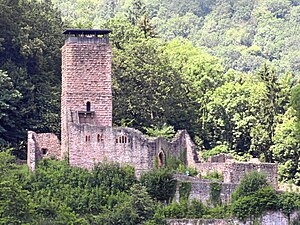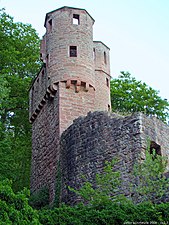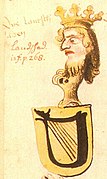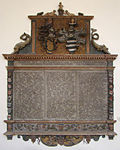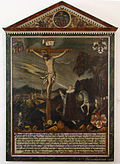Landschad von Steinach

The Landschad von Steinach were a medieval lower noble family in the Odenwald with ancestral seat in Steinach am Neckar , which was first mentioned in the 12th century as feudal people of the bishops of Speyer , later provided several high Palatinate officials and became extinct in 1653 in the male line.
history
The lords of Steinach and their castles
According to old sources, the ancestor of the family is said to have come from Meissen and was in the service of the bishops of Worms . The Hinterburg in Neckarsteinach, built around 1100, is the ancestral castle of the noble free von Steinach, who received them as a fiefdom of the Worms diocese. From this point the lord of the castle could see and monitor the Steinach valley and the Neckar valley. A Bligger von Steinach was first mentioned in 1142, a brother of the later Bishop Conrad I von Worms († 1171). The Lords of Steinach originally had a blue and white split coat of arms. Bligger's son, Bligger II von Steinach , had the castle expanded and was known as a minstrel . In the wake of Henry VI. he was several times in Italy. The great Heidelberg song manuscript, the Codex Manesse , contains a miniature as well as three songs by him and one of his poems praises Gottfried von Straßburg in Tristan und Isolde . Bligger II chose a new coat of arms showing a harp. It was taken over by future generations of the noble family (with a modified tincture ) and has been preserved as the coat of arms of the city of Neckarsteinach to this day . The crest of the coat of arms is a crowned male head with blazing hair and beard, which is interpreted as King David or the head of a Turk.
The brother of the poet, Conrad I. von Steinach, who as a younger son had no share in his father's castle, had the middle castle built on the same mountain tongue in 1165 . Conrad's line died out around 1325 with the death of Boppo von Steinach, after which the Mittelburg fell to his sons-in-law Conrad von Erbach and Luzzo von Helmstatt . It was rebuilt into a renaissance castle around 1550 and gothicised in the 19th century . The Mittelburg is now inhabited by the Barons von Warsberg .
The three sons of the poet Bligger II shared the paternal property: Conrad II received the rear castle, but his line died out with his grandchildren around 1270. Bligger III. († 1228) built the Harfenburg near Heddesbach and founded the line of the Lords of Harfenberg , which was last mentioned around 1326. The gentlemen von Hirschhorn probably descended from a side branch of the Harfenberg family .
The youngest son of the poet, Ulrich I, built the Vorderburg in Steinach and also had three sons: Bligger V., Conrad and Ulrich II, of whom the eldest, Bligger V., inherited the Vorderburg, while his brother Conrad inherited a clergy Career started. Ulrich II. Finally built the fourth and smallest castle near Steinach, Schadeck Castle . The name of the castle, earlier also Schadheck (means swallow's nest, skad is an outdated synonym for swallow, hecken a synonym for brood).
The four castles are to the west of Neckarsteinach :
Vorderburg (around 1200)
Middle Castle (1165)
Hinterburg (around 1100)
Schadeck (swallow's nest) (around 1230)
Vorderburg , Mittelburg , Hinterburg and Schadeck (also: swallow's nest). The castles were built between 1100 and 1230 by the Landschad von Steinach, partly as a Worms or Speyr fiefdom, partly as an allodial property , and in the late Middle Ages they were partly in fiefdoms of various other lords of the lower nobility. In the 16th century they all came back into the possession of the Landschad and after their extinction in 1653 in the possession of a line of those of Metternich , after their extinction in 1753 in the hands of the dioceses of Worms and Speyer and in the course of mediation in 1803 to the Grand Duchy of Hesse. The front and middle castle today belong to the barons of Warsberg -Dorth; Hinterburg and Schadeck are ruins.
The Landschad von Steinach as the most important line
Ulrichs II's line was called Landschad von Steinach to distinguish it from the other lines . During the Romantic era , this name was often mistakenly associated with robber knights who raged "to the detriment of the country". However, there is no documentary evidence of the family's activity as robber barons and the name refers rather to Schadeck Castle . A Bligger Landschad was first mentioned in 1286, a grandson of Ulrich II, Ulrich Landschad, appeared in 1314.

After the older line of Bligger V had died out, the Landschad von Steinach inherited the Vorderburg. Ulrich Landschad's sons, Bligger X. and Dieter I. Landschad, then ceded Schadeck to the Worms and Mainz monasteries in 1335. Dieter's son Conrad acquired properties on Bergstrasse and Haardt . He and his son Contz († 1417) are buried in Neustadt. Bliggers X. sons, Heinrich Bligger the Elder (XI.) († 1396), Bligger the Younger (XII.) († 1393) and Hennel († September 3, 1377) were followers of Count Palatine Ruprecht .
Heinrich Bligger the elder son Dieter II came to great wealth through marriage with Irmgard Kämmerer and held many castles as pledges, including Neidenfels Castle . His prosperity led to his nickname the rich . He lived in Möckmühl . Since he only had three daughters, his property went to the daughters as a dowry and later as an inheritance (Katharina was married to Hans von Gemmingen the Rich , the progenitor of the Gemmingen-Guttenberg line), whereas his younger brother Blicker XIII. continued the family line with his sons Dieter III, Conrad and Ulrich VII. Conrad became the canon of Aschaffenburg , the youngest brother Ulrich VII became burgrave in Alzey . The eldest brother, Dieter III., Remained lord of the castle in Steinach and also had three sons: Blicker XIV., Hans II. And Dieter V. († 1496). Hans II probably remained childless, Dieter V received castle fiefs in Oppenheim and Alzey in 1482 , but his line died out with his grandchildren.
Blicker XIV. († 1499) became court master of the Palatinate and received numerous fiefs from Friedrich I. He was married to Mia von Helmstatt († 1496). The couple's double grave has been preserved in the Neckarsteinach church to this day. They had two sons: Hans III. (1465–1531) and Blicker XV. († around 1519).
Viewer XV. was Vogt in Pforzheim and founded the branch line to Gundelsheim , which with his sons Bleickard XVI. the Oberamtmann von Falkenstein and Vogt von Mosbach , Philipp a Teutonic Order - Komtur in Weinheim and Friedrich I. the Vogt von Geislingen. The line died out with Hans Bleickard II († 1600).
Hans III. first served the Hungarian King Matthias , later Emperor Maximilian I and was knighted in Jerusalem. Then he entered service in the Palatinate. In the Bavarian-Palatinate War of Succession from 1504 he commanded the Palatinate troops on the lower Nahe during the siege of the Disibodenberg monastery and the town of Odernheim am Glan . Count Palatine Ludwig appointed Hans III. to his adviser and until 1514 to his court marshal. As the local lord of Steinach , Hans III reformed . - probably under the impression of Martin Luther's appearance at the Heidelberg disputation in 1518 - the place already in 1522 and in 1524 called the Protestant pastor Jakob Otter to Steinach. As early as October 1520 he had asked Elector Friedrich of Saxony for protection for Luther, and in 1522 he advocated Luther's teaching in a letter to Count Palatine Ludwig. Hans III spent the last 20 years of his life. on the Vorderburg in Steinach, he is said to have been paralyzed from gout at times. With his two wives Lucia von Nippenburg († 1503) and Margareta von Fleckenstein († 1530) he had two sons each: Hans IV. (1500–1571) and Bernhard († before 1529) and Christof I (1507–1587) and Hans Pleickard I. († 1583), also a daughter Anna from the first marriage. Bernhard died young, leaving behind only one daughter, the other three sons were the progenitors of three family lines that died out almost simultaneously in the middle of the 17th century.
Hans IV. Continued the main line on the Vorderburg, was Vogt of Mosbach and Durlach and, through his second marriage to Margarete von Erligheim, received the fiefs of the lords of Erligheim , who died out in the male line . a. the place Ilvesheim , where he died in 1571. His sons were Hans Ulrich I. (mentioned 1566-1619) and Ottheinrich († 1604). The latter was court master and bailiff in Zweibrücken and died childless. Hans Ulrich I. continued the family line on the Vorderburg. From three marriages he had a total of nine children. Five of his six sons died at a young age or without children (Hans Friedrich was shot in Strasbourg in 1592, Hans Ulrich II died in 1621 during the siege of Heidelberg), the third son Dieter VIII (1574-1625) left only three daughters.
Hans Pleickard I was initially Vogt of the Bishops of Speyer, but resigned from this office after 1540, presumably for reasons of faith. In 1546 he was the Palatine marshal and grand steward, in 1565 Vogt of Mosbach. After the death of Friedrich von Eicholzheim, he received the villages of Großeicholzheim and Heidersbach ( Limbach (Baden) ) as a fief. He was married to Anna Elisabeth von Helmstatt († 1590), with whom he had four sons and four daughters. The younger sons seem to have died childless. The eldest son, Hans Philipp, was a councilor from the Palatinate, temporarily a bailiff in Böckelheim (today Schloßböckelheim , district 'Schloss'), Bacherach , Boxberg and Bretten . He had a son, Friedrich Pleickard, who died childless before 1620.
Christof II resided in the middle castle and became court master in Zweibrücken. His first marriage was to Anna von Gemmingen († 1562), his second marriage from 1564 to Kunigunde Echter von Mespelbrunn († 1585). The first marriage had five children, including three sons: Hans V., Hans Dieter and Johann Bleikard. Hans V. (* 1537; † around 1597) was burgrave of Starkenburg , he was also court marshal of the Palatinate and bailiff of Mosbach. He survived most of his eleven children, of whom only Hans Cristoph Bligger (* 1575; † after 1632) had offspring. He was the Palatinate sub-marshal and 1612 senior bailiff in Germersheim. From 1616 to 1621 he was Vogt zu Mosbach and in 1622 he was involved in the defense of Heidelberg. In 1632 he was named as Oberamtmann in Mosbach. He was married to Ursula Kunigunde von Hirschhorn († 1630). Of their eight children, only three reached adulthood. The only son, Friedrich III. (1601–1653) survived his childless son Heinrich Christian Georg († 1631), so that the sex with him died out in the male line in 1653. His daughter and heiress, Ursula Christine, married Philipp Ernst von Venningen .
coat of arms
The coat of arms shows a black harp with red strings on a gold background. In Scheibler's book of arms, in particular, the instrument frame appears in the shape of a dragon with a corresponding dragon head, the ears and tongue of which are painted red. The helmet covers are black and gold. The crest depicts a crowned male head with flowing hair and a full beard . Similar to the depiction on medieval playing cards, the drawing of the head is called drollery .
- coat of arms
Coat of arms in the Ingeram Codex
Coat of arms in Siebmacher's coat of arms book
Coat of arms on the remains of a tombstone, Neustadt collegiate church
- Epitaphs in the church in Neckarsteinach
See also
Individual evidence
- ↑ Bühler: Burgen der Kurpfalz, Heidelberg 1990, p. 79ff .: The Lords of Steinach and the basis of their rule
- ↑ "Heinrich called Blicker Landschad von Steinach 1396, Neckarsteinach". Grave monuments in Hesse until 1650. In: Landesgeschichtliches Informationssystem Hessen (LAGIS).
- ^ G. Berbig: A letter from the knight Hans Lantschad zu Steinach to Elector Friedrich the Wise. 1520 , in: ARG II (1904/05) pp. 391-395.
- ↑ Ain Missiue from the strict and firm H. Hans Landtschadt zu Steynach , ... o. O. 1522, unpaginated copy of the Heidelberg University Library. ( Digitized version )
- ↑ Matthäus Merian (editor and illustrator) and Martin Zeiller (text author): Topographia Palatinatus Rheni. Merian, Frankfurt am Main 1645, p. 15. ( Text on Wikisource )
- ^ Johann Goswin Widder: Attempt of a complete geographical-historical description of the Kurfürstl. Palatinate on the Rhine by Johann Goswin Widder. Fourth and last part. Frankfurt and Leipzig 1788, p. 101
literature
- Johann Friedrich Gauhe : Genealogical-Historical Adels-Lexicon . Johann Friedrich Gleditsch, Leipzig 1740
- Johann Gottfried Biedermann : Gender register of the Reichs Frey immediate knight creates land to Francken praiseworthy place Ottenwald . Kulmbach 1751. Plate CCCLXIV. to CCCLXVI. ( Digitized version )
- Walter Möller, Karl Krauss: Neckarsteinach, his lords, the city and the castles , Mainz 1928
- Christoph Bühler: Burgen der Kurpfalz - Bergstrasse and Neckartal , Heidelberg 1990, therein p. 79 ff .: The Lords of Steinach and the basis of their rule
- LANDSCHAD . In: Nadine Sauer: Families in Neckarsteinach, 1603–1900. Volume I: The Protestant Church Books , Neckarsteinach 1999, ( DNB 959404473 ), pp. 312, 344–345.
- Erhard Hinz: The coat of arms of the lords and land damage of Steinach. A contribution to regional history . Verlag Regionalkultur, Heidelberg et al. 2012, ISBN 978-3-89735-717-4




